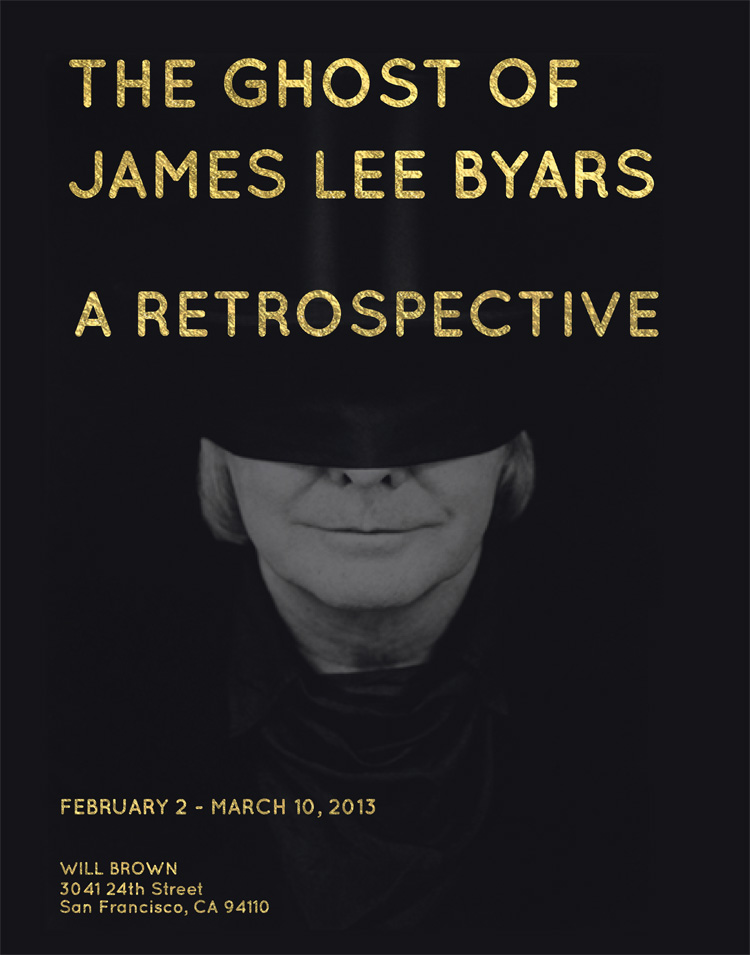
The Ghost of James Lee Byars: A Retrospective
February 2 - March 10, 2013
Opening Reception
Saturday, February 2, 2013, 8-11PM
For five weeks, Will Brown restages The Ghost of James Lee Byars, the artist’s seminal 1969 work; a completely lightless environment. Inside The Ghost of James Lee Byars, Will Brown hosts a comprehensive collection of the artist’s work.
Sample contents include:
1968. A Mile of Red Acetate Parades Up 65th Street, New York Times, September 13, 1968.
1978. "I cancel all my works at death."
1982/94. The Death of James Lee Byars.
Date Unknown. Mercedes Exit.
1997. Artist dies in Cairo.
One of the most compelling and under-recognized artists of the 20th century, James Lee Byars lived at the center of his countless creations. Far removed from the notion of the artwork as a collectible or reproducible object, Byars was instead interested in creating an alternate and romantic form of living, one that was both of this world and beyond it. He valued questions over answers, absence over presence, and ambiguity over clarity. His obsession with perfection, paradox, and death—specifically his own—took him around the world many times over, moving regularly between his birthplace of Detroit (1932), Kyoto, Bern, Los Angeles, New York, and Cairo, his final resting place (1997).
Always dressed in full black, gold, or red costume, his performances, objects, "performable objects," actions, questions, proposals, letters, books, and epitaphs have taken on mythological status. He kept no calendar and often wore a straight jacket; he owned only four books at a time, replacing them as he read them. He once climbed the Furka Pass in Switzerland to place a drop of black perfume on a rock. His works, many without title or documentation, are momentary parts of an impossible whole—one which has never before been collectively shown.
The Ghost of James Lee Byars, one of the artist’s most seminal and difficult works, was first installed in Düsseldorf in 1969. An empty, pitch-black room, the work has since been recreated in several group exhibitions, each providing the darkness with a different reading based on the context in which it’s displayed—the supernatural, the artist as shaman or medium, the monochrome, the void, minimalism, or the connection between the paranormal and conceptualism. Given the artist’s reluctance to make absolute statements in favor of open interpretation, these readings could be all accurate, or at least applicable. “Make me up as you wish,” he once proclaimed during an interview.
The Ghost of James Lee Byars: A Retrospective presents a complete collection of the works of the enigmatic and prolific artist inside the darkness of The Ghost of James Lee Byars. Like a crypt, the exhibition contains the remains of every proposal, every unphotographed action, every “perfect” sculpture, every speeding taxi, and, given the title, perhaps even the artist himself. The exhibition takes a series of questions as inspiration: How can we appropriately construct a retrospective for an artist whose work is inseparable from his physical presence? How can we contend with an artist who so presciently declared all of his works “canceled” upon his death? Can a gallery be a container for ideas rather than objects?
A reading room is installed in the backroom of the gallery with a growing collection of books, articles, and photographs related to the artist’s life and work. We invite you to pass through the The Ghost of James Lee Byars en route to the reading room and to contribute any Byars-related material to its collection for the run of the exhibition.
Related programming will explore the tension between what we know and what we don't; between sight and knowledge, this side and the other. A calendar of events will be made available shortly.

